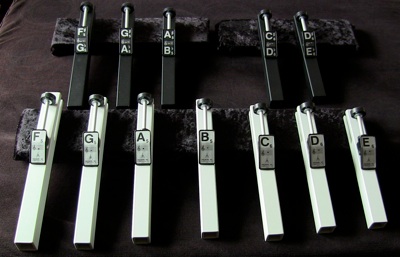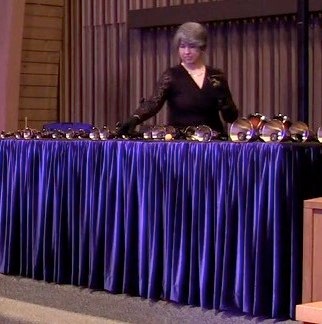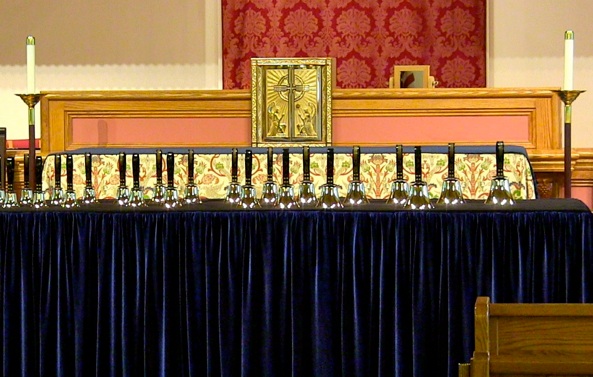Rudy Rodriquez designed and built these bass bell boxes to help his son ring large bells, and he kindly granted permission for me to share his instructions and drawings with you to download for personal use. Continue reading Bass bell boxes by Rudy Rodriquez
Category Archives: Equipment
Chimes in solo work
There are special challenges to ringing chimes in solos. They are harder to pick up quickly than bells and require modification of multiple bell techniques. Continue reading Chimes in solo work
Polishing supplies
At least once a year, polish the outer castings of your bells with polishing cream to remove spots and other marks left behind during routine wipedowns. To save time in preparing for this annual ritual, I store most of my polishing supplies together in plastic boxes. Some of the items, like a vacuum cleaner, are obviously used for other purposes during the rest of the year. If you’re preparing for your first polishing session, here’s what I suggest you gather. Click here for this checklist as a downloadable PDF: Polishing supplies checklist Continue reading Polishing supplies
Table covers – making your own – separate top/skirt
See the other articles in this series, especially Table covers – choices, which discusses the most common fabrics used. Also search online for articles and videos about working with your chosen fabric, as well as any sewing techniques you want to brush up on.
Separating your table covers into top and skirt portions facilitates handling and storing large covers, practicing on your performance table tops without the skirts, and laundering the top when needed (or even shaking away dust and lint). The classic attachment mechanism is Velcro. However, this isn’t required by law; you might try snap tape, for instance, or hooks and eyes, or even pins. Continue reading Table covers – making your own – separate top/skirt
Table covers – making your own – gathered skirts
See the other articles in this series, especially Table covers – choices, which discusses the most common fabrics used. Also search online for articles and videos about working with your chosen fabric, as well as any sewing techniques you want to brush up on.
Some background: My sewing machine is a Pfaff model 6122 with a walking foot (helpful, but not essential). I have many years of experience sewing, having made my own clothes in high school, plus a decade of making things for the boat, using heavy fabrics without patterns. I would say this project requires a medium-duty machine and sewing skills beyond basic, but much less than expert. A quilter used to dealing with large pieces of fabric would have no trouble. The exception would be working with real velvet (instead of a substitute like velour); I feel prior experience with that fabric is needed for such a large project. Continue reading Table covers – making your own – gathered skirts
Table covers – making your own – buying supplies
See the other articles in this series, especially Table covers – choices, which discusses the most common fabrics used. Also search online for articles and videos about working with your chosen fabric, as well as any sewing techniques you want to brush up on.
Making your own table covers isn’t as difficult as making a wedding dress or a tailored suit. However, you must feel confident making things without patterns. If you hesitate to improvise, mock up the covers in muslin first. Test your ideas and make all your mistakes on muslin, which is cheap. Then buy the expensive fabric and use the muslin version as a model. If you baste the Velcro in place with large stitches, you can remove it to use on the real covers. Continue reading Table covers – making your own – buying supplies
Table covers – choices
Almost the first thing the audience sees at your concert is your table dressing. Make it convey the image you want to project. As a beginning soloist, you’ll probably use table covers provided by whatever organization lends you bells. If not, you can buy a length of heavy black cotton corduroy, cut to the length of your table plus 1 yard. Hem the cut ends, and lay it over the foam. Once you’ve settled on your table configuration (including height), it’s time to start thinking about performance table covers. If you decide to make your own covers, you can incorporate your piece of black corduroy as the table top, or continue to use it as a practice cover. Continue reading Table covers – choices
Foam pads
Foam pads on handbell tables keep bells from rolling and protect them during techniques like martellato, where the bell is “hammered” on the table. As with tables, choices you make about foam can affect the fit of your table covers, so it’s best to pin down the details before having covers made. Handbell choirs usually use foam sized to fit the table width, then cut into manageable lengths. A typical foam pad is 3’ or 4’ long by 30” wide. Preferred thickness is usually 3 or 4 inches. Most soloists use the same thickness, both because they often use equipment belonging to their church bell choirs, and because, without adjustable tables, they need foam to raise the ringing height. Continue reading Foam pads
Tables
Like bells, tables are a long-term purchase decision, so worth shopping around for. The main issues to consider are:
• Generic or specialized
• Features
• Length – both individual table length and total feet
• Brand Continue reading Tables
Buying bells: new vs. used (for sellers, too)
Though I’m not a professional appraiser or broker, I’ve been contacted for advice by many people interested in buying or selling bells. Here’s some information you may find helpful, whether as a buyer or a seller. In all cases, I’m talking about handbells commonly played as a musical instrument, not rare or antique bells you may collect for other reasons. Continue reading Buying bells: new vs. used (for sellers, too)



